Evaluating Negligence: A Tort Law Case Study on Personal Injury Claim
VerifiedAdded on 2020/04/01
|7
|1186
|242
Case Study
AI Summary
This case study examines a negligence claim where Rebecca seeks compensation from Michelle for injuries sustained in a car accident. The analysis focuses on whether Michelle, the driver, owed Rebecca a duty of care and breached that duty through negligent actions, specifically driving under the influence. The study applies legal principles from common law and the Civil Liability Act 2002 (NSW) to assess the elements of negligence, including duty of care, breach of standard of care, and causation. Furthermore, it explores the concept of contributory negligence, considering whether Rebecca's decision to ride with Michelle, knowing she was intoxicated, impacts her claim. The conclusion determines that while Rebecca can claim against Michelle for negligence, the damages awarded may be reduced proportionally due to her contributory negligence. Desklib provides access to similar case studies and solved assignments for students.
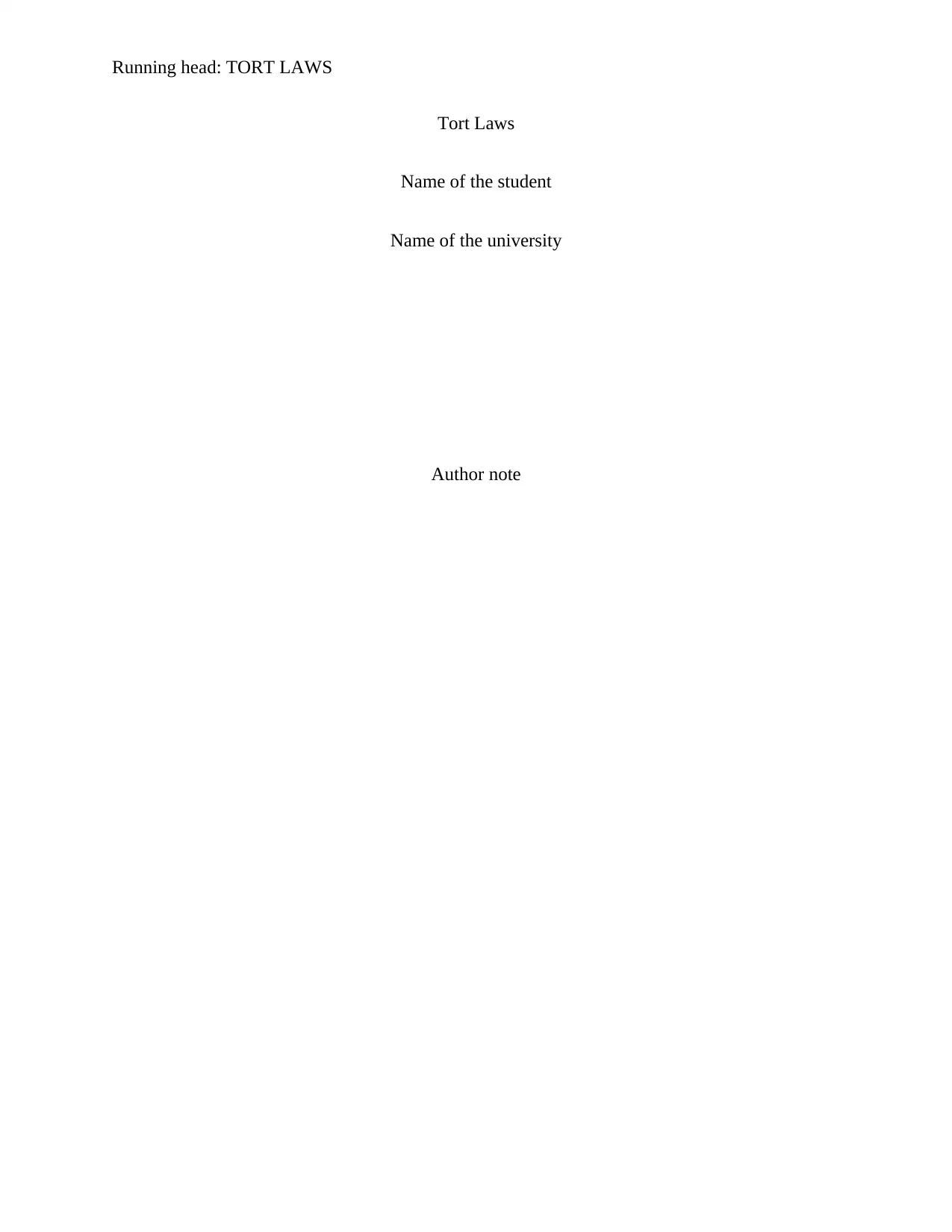
Running head: TORT LAWS
Tort Laws
Name of the student
Name of the university
Author note
Tort Laws
Name of the student
Name of the university
Author note
Paraphrase This Document
Need a fresh take? Get an instant paraphrase of this document with our AI Paraphraser
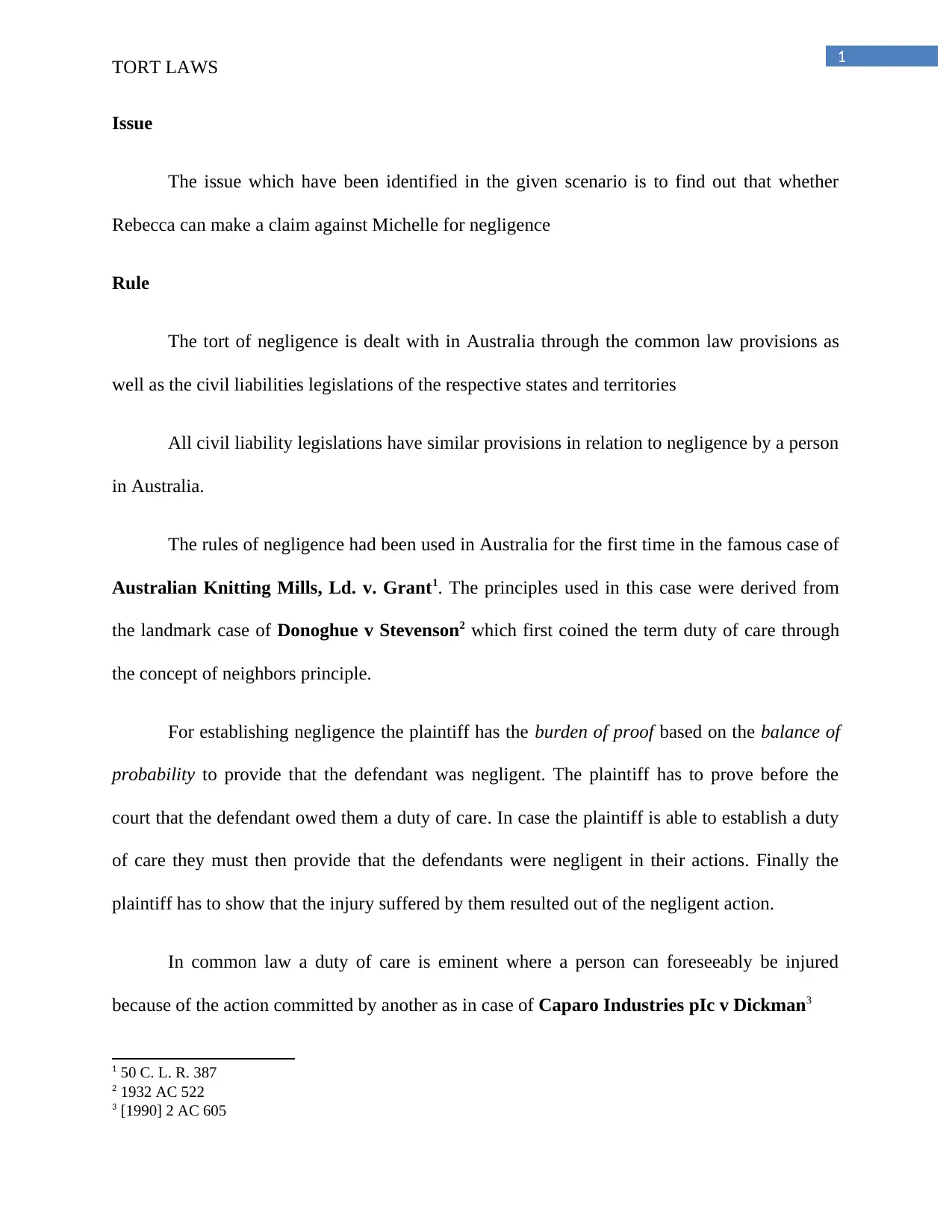
1
TORT LAWS
Issue
The issue which have been identified in the given scenario is to find out that whether
Rebecca can make a claim against Michelle for negligence
Rule
The tort of negligence is dealt with in Australia through the common law provisions as
well as the civil liabilities legislations of the respective states and territories
All civil liability legislations have similar provisions in relation to negligence by a person
in Australia.
The rules of negligence had been used in Australia for the first time in the famous case of
Australian Knitting Mills, Ld. v. Grant1. The principles used in this case were derived from
the landmark case of Donoghue v Stevenson2 which first coined the term duty of care through
the concept of neighbors principle.
For establishing negligence the plaintiff has the burden of proof based on the balance of
probability to provide that the defendant was negligent. The plaintiff has to prove before the
court that the defendant owed them a duty of care. In case the plaintiff is able to establish a duty
of care they must then provide that the defendants were negligent in their actions. Finally the
plaintiff has to show that the injury suffered by them resulted out of the negligent action.
In common law a duty of care is eminent where a person can foreseeably be injured
because of the action committed by another as in case of Caparo Industries pIc v Dickman3
1 50 C. L. R. 387
2 1932 AC 522
3 [1990] 2 AC 605
TORT LAWS
Issue
The issue which have been identified in the given scenario is to find out that whether
Rebecca can make a claim against Michelle for negligence
Rule
The tort of negligence is dealt with in Australia through the common law provisions as
well as the civil liabilities legislations of the respective states and territories
All civil liability legislations have similar provisions in relation to negligence by a person
in Australia.
The rules of negligence had been used in Australia for the first time in the famous case of
Australian Knitting Mills, Ld. v. Grant1. The principles used in this case were derived from
the landmark case of Donoghue v Stevenson2 which first coined the term duty of care through
the concept of neighbors principle.
For establishing negligence the plaintiff has the burden of proof based on the balance of
probability to provide that the defendant was negligent. The plaintiff has to prove before the
court that the defendant owed them a duty of care. In case the plaintiff is able to establish a duty
of care they must then provide that the defendants were negligent in their actions. Finally the
plaintiff has to show that the injury suffered by them resulted out of the negligent action.
In common law a duty of care is eminent where a person can foreseeably be injured
because of the action committed by another as in case of Caparo Industries pIc v Dickman3
1 50 C. L. R. 387
2 1932 AC 522
3 [1990] 2 AC 605

2
TORT LAWS
If a reasonable person implemented better care to avoid the injury the duty is said to
violated as provided by Vaughan v Menlove 4
Factual causation is determined through the application of the But For test where if the
injury would have not been caused unless the act was committed negligence is not establishes
according to Barnett v Chelsea & Kensington Hospital5
The civil Liability Act 2002 (NSW)6 defines negligence through s5 as a failure on the
part of the person to take reasonable care and exercised due skills. The court in the case of
D'Arcy v Corporation of the Synod of the Diocese of Brisbane7 ruled that a person can be
held negligent in relation to his acts if the injury which has been caused to another person could
have been foreseen. In addition the effect of the injury on the person were significant and a
person who if applied reasonable skills and care in the situation could have avoided causing the
injury.
In the case of Liverpool Catholic Club Ltd v Moor8 the court ruled that whether an
action is due implementation of reasonable skill and care is determined by analyzing the
probability of the injury in case care not observed, how serious the injury can be caused, the
precaution taking Burden and the utility of the action causing the injury socially.
In the case of Stokes v House With No Steps9 it had been ruled by the court whether the
negligent act was a significant part of the injury is necessary to determine the claim of
4 (1837) 3 Bing. N.C. 467
5 [1969] 1 QB 428
6 The civil Liability Act 2002 (NSW)
7 [2017] QSC 103
8 [2014] NSWCA 394
9 [2016] QSC 79
TORT LAWS
If a reasonable person implemented better care to avoid the injury the duty is said to
violated as provided by Vaughan v Menlove 4
Factual causation is determined through the application of the But For test where if the
injury would have not been caused unless the act was committed negligence is not establishes
according to Barnett v Chelsea & Kensington Hospital5
The civil Liability Act 2002 (NSW)6 defines negligence through s5 as a failure on the
part of the person to take reasonable care and exercised due skills. The court in the case of
D'Arcy v Corporation of the Synod of the Diocese of Brisbane7 ruled that a person can be
held negligent in relation to his acts if the injury which has been caused to another person could
have been foreseen. In addition the effect of the injury on the person were significant and a
person who if applied reasonable skills and care in the situation could have avoided causing the
injury.
In the case of Liverpool Catholic Club Ltd v Moor8 the court ruled that whether an
action is due implementation of reasonable skill and care is determined by analyzing the
probability of the injury in case care not observed, how serious the injury can be caused, the
precaution taking Burden and the utility of the action causing the injury socially.
In the case of Stokes v House With No Steps9 it had been ruled by the court whether the
negligent act was a significant part of the injury is necessary to determine the claim of
4 (1837) 3 Bing. N.C. 467
5 [1969] 1 QB 428
6 The civil Liability Act 2002 (NSW)
7 [2017] QSC 103
8 [2014] NSWCA 394
9 [2016] QSC 79
⊘ This is a preview!⊘
Do you want full access?
Subscribe today to unlock all pages.

Trusted by 1+ million students worldwide
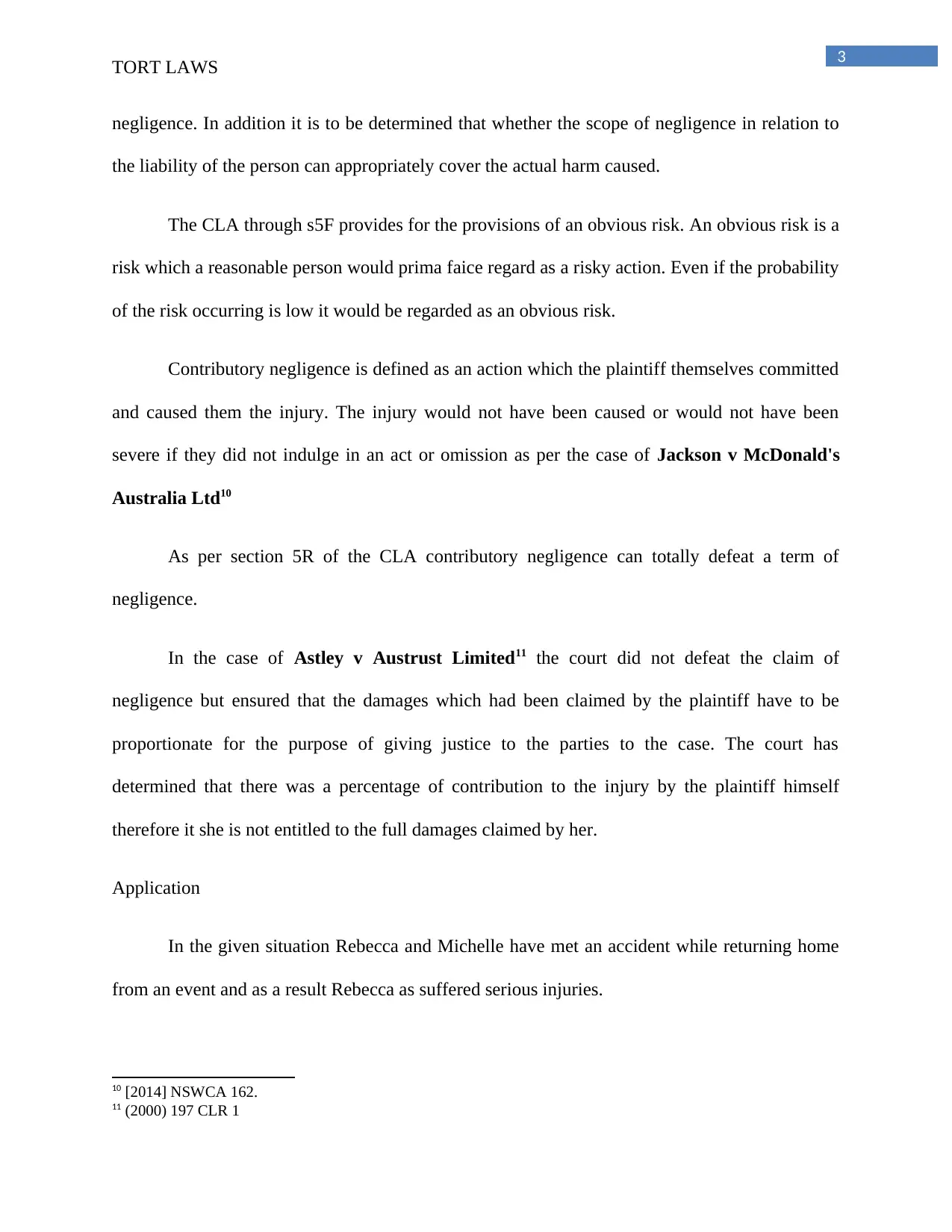
3
TORT LAWS
negligence. In addition it is to be determined that whether the scope of negligence in relation to
the liability of the person can appropriately cover the actual harm caused.
The CLA through s5F provides for the provisions of an obvious risk. An obvious risk is a
risk which a reasonable person would prima faice regard as a risky action. Even if the probability
of the risk occurring is low it would be regarded as an obvious risk.
Contributory negligence is defined as an action which the plaintiff themselves committed
and caused them the injury. The injury would not have been caused or would not have been
severe if they did not indulge in an act or omission as per the case of Jackson v McDonald's
Australia Ltd10
As per section 5R of the CLA contributory negligence can totally defeat a term of
negligence.
In the case of Astley v Austrust Limited11 the court did not defeat the claim of
negligence but ensured that the damages which had been claimed by the plaintiff have to be
proportionate for the purpose of giving justice to the parties to the case. The court has
determined that there was a percentage of contribution to the injury by the plaintiff himself
therefore it she is not entitled to the full damages claimed by her.
Application
In the given situation Rebecca and Michelle have met an accident while returning home
from an event and as a result Rebecca as suffered serious injuries.
10 [2014] NSWCA 162.
11 (2000) 197 CLR 1
TORT LAWS
negligence. In addition it is to be determined that whether the scope of negligence in relation to
the liability of the person can appropriately cover the actual harm caused.
The CLA through s5F provides for the provisions of an obvious risk. An obvious risk is a
risk which a reasonable person would prima faice regard as a risky action. Even if the probability
of the risk occurring is low it would be regarded as an obvious risk.
Contributory negligence is defined as an action which the plaintiff themselves committed
and caused them the injury. The injury would not have been caused or would not have been
severe if they did not indulge in an act or omission as per the case of Jackson v McDonald's
Australia Ltd10
As per section 5R of the CLA contributory negligence can totally defeat a term of
negligence.
In the case of Astley v Austrust Limited11 the court did not defeat the claim of
negligence but ensured that the damages which had been claimed by the plaintiff have to be
proportionate for the purpose of giving justice to the parties to the case. The court has
determined that there was a percentage of contribution to the injury by the plaintiff himself
therefore it she is not entitled to the full damages claimed by her.
Application
In the given situation Rebecca and Michelle have met an accident while returning home
from an event and as a result Rebecca as suffered serious injuries.
10 [2014] NSWCA 162.
11 (2000) 197 CLR 1
Paraphrase This Document
Need a fresh take? Get an instant paraphrase of this document with our AI Paraphraser
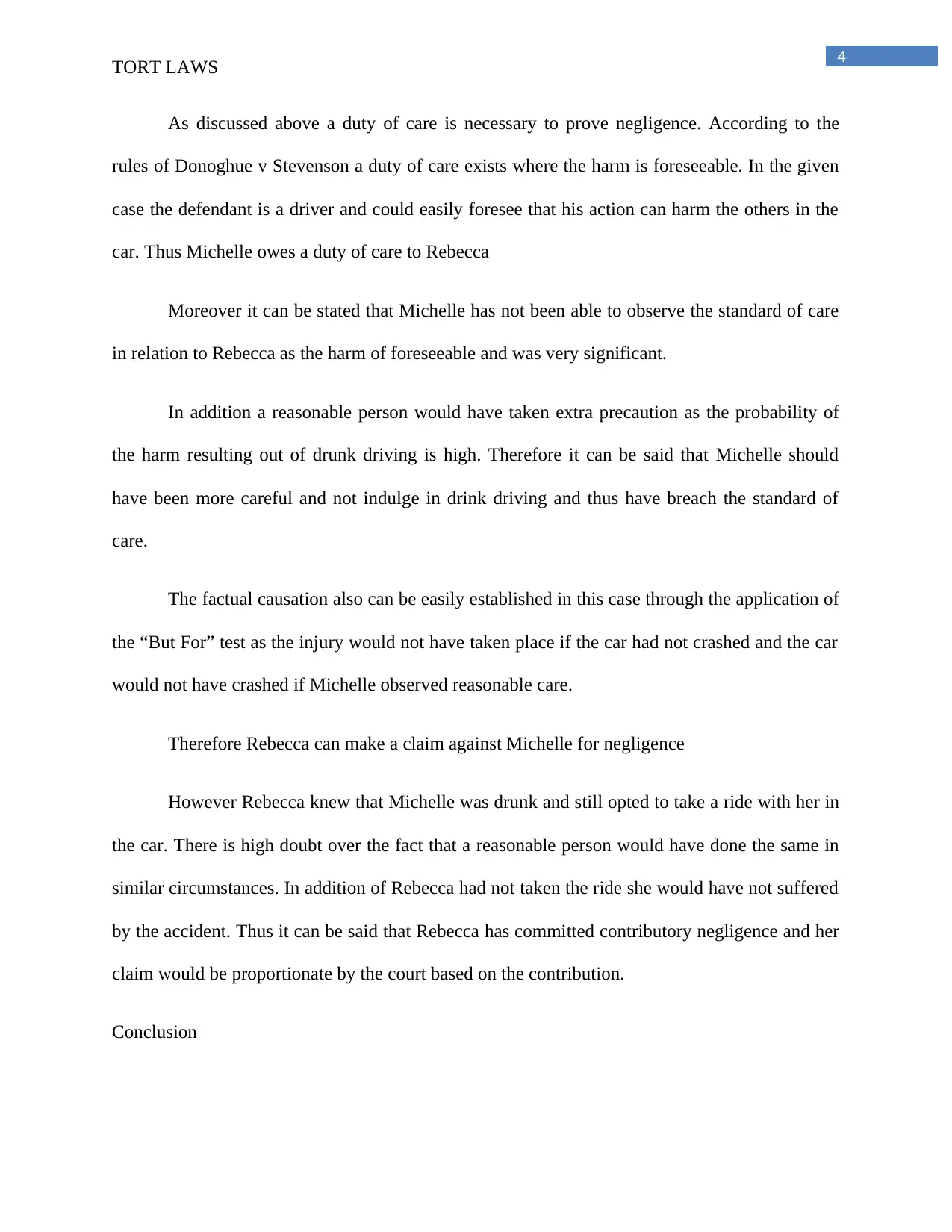
4
TORT LAWS
As discussed above a duty of care is necessary to prove negligence. According to the
rules of Donoghue v Stevenson a duty of care exists where the harm is foreseeable. In the given
case the defendant is a driver and could easily foresee that his action can harm the others in the
car. Thus Michelle owes a duty of care to Rebecca
Moreover it can be stated that Michelle has not been able to observe the standard of care
in relation to Rebecca as the harm of foreseeable and was very significant.
In addition a reasonable person would have taken extra precaution as the probability of
the harm resulting out of drunk driving is high. Therefore it can be said that Michelle should
have been more careful and not indulge in drink driving and thus have breach the standard of
care.
The factual causation also can be easily established in this case through the application of
the “But For” test as the injury would not have taken place if the car had not crashed and the car
would not have crashed if Michelle observed reasonable care.
Therefore Rebecca can make a claim against Michelle for negligence
However Rebecca knew that Michelle was drunk and still opted to take a ride with her in
the car. There is high doubt over the fact that a reasonable person would have done the same in
similar circumstances. In addition of Rebecca had not taken the ride she would have not suffered
by the accident. Thus it can be said that Rebecca has committed contributory negligence and her
claim would be proportionate by the court based on the contribution.
Conclusion
TORT LAWS
As discussed above a duty of care is necessary to prove negligence. According to the
rules of Donoghue v Stevenson a duty of care exists where the harm is foreseeable. In the given
case the defendant is a driver and could easily foresee that his action can harm the others in the
car. Thus Michelle owes a duty of care to Rebecca
Moreover it can be stated that Michelle has not been able to observe the standard of care
in relation to Rebecca as the harm of foreseeable and was very significant.
In addition a reasonable person would have taken extra precaution as the probability of
the harm resulting out of drunk driving is high. Therefore it can be said that Michelle should
have been more careful and not indulge in drink driving and thus have breach the standard of
care.
The factual causation also can be easily established in this case through the application of
the “But For” test as the injury would not have taken place if the car had not crashed and the car
would not have crashed if Michelle observed reasonable care.
Therefore Rebecca can make a claim against Michelle for negligence
However Rebecca knew that Michelle was drunk and still opted to take a ride with her in
the car. There is high doubt over the fact that a reasonable person would have done the same in
similar circumstances. In addition of Rebecca had not taken the ride she would have not suffered
by the accident. Thus it can be said that Rebecca has committed contributory negligence and her
claim would be proportionate by the court based on the contribution.
Conclusion

5
TORT LAWS
Rebecca can make a claim against Michelle but her claim would be adjusted by the court
based on negligence.
TORT LAWS
Rebecca can make a claim against Michelle but her claim would be adjusted by the court
based on negligence.
⊘ This is a preview!⊘
Do you want full access?
Subscribe today to unlock all pages.

Trusted by 1+ million students worldwide
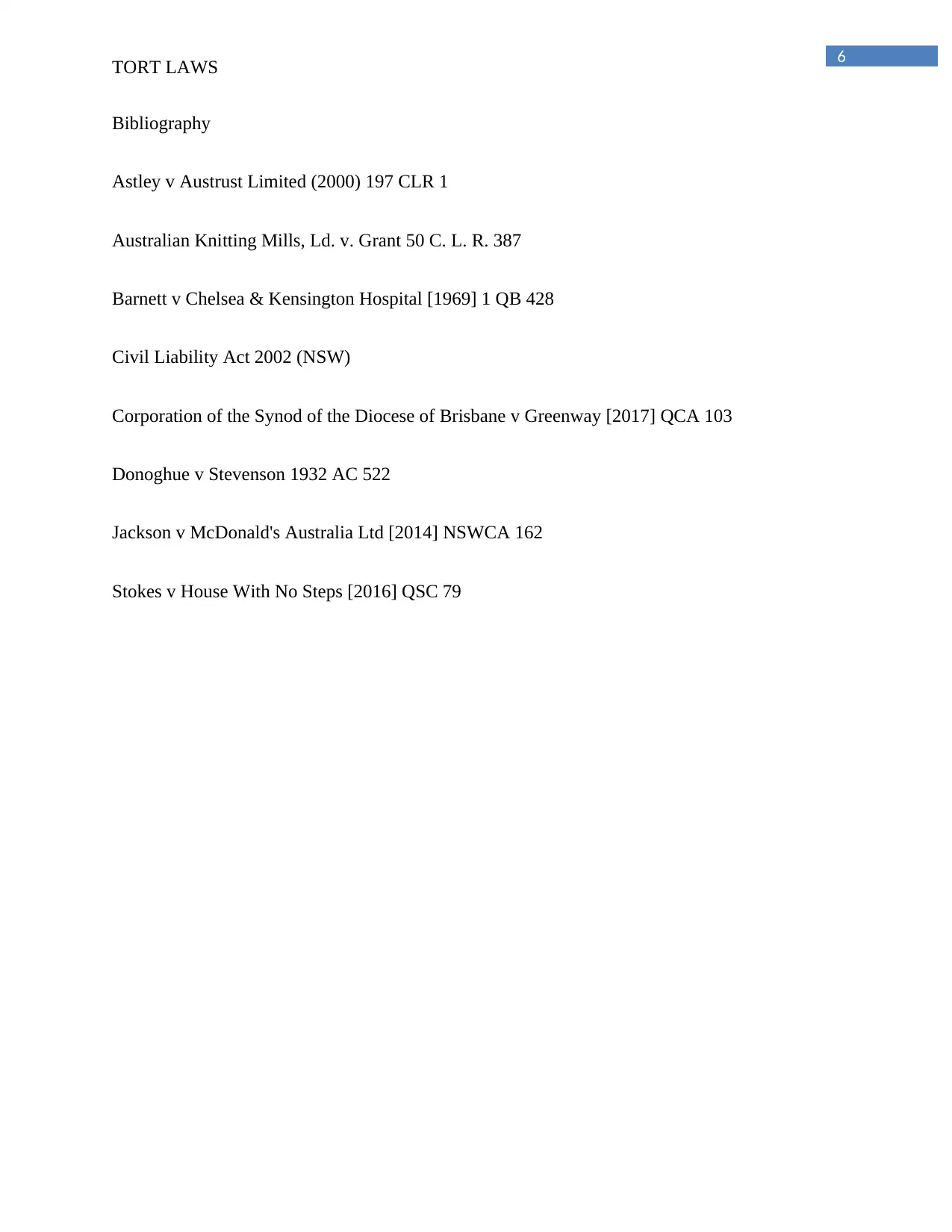
6
TORT LAWS
Bibliography
Astley v Austrust Limited (2000) 197 CLR 1
Australian Knitting Mills, Ld. v. Grant 50 C. L. R. 387
Barnett v Chelsea & Kensington Hospital [1969] 1 QB 428
Civil Liability Act 2002 (NSW)
Corporation of the Synod of the Diocese of Brisbane v Greenway [2017] QCA 103
Donoghue v Stevenson 1932 AC 522
Jackson v McDonald's Australia Ltd [2014] NSWCA 162
Stokes v House With No Steps [2016] QSC 79
TORT LAWS
Bibliography
Astley v Austrust Limited (2000) 197 CLR 1
Australian Knitting Mills, Ld. v. Grant 50 C. L. R. 387
Barnett v Chelsea & Kensington Hospital [1969] 1 QB 428
Civil Liability Act 2002 (NSW)
Corporation of the Synod of the Diocese of Brisbane v Greenway [2017] QCA 103
Donoghue v Stevenson 1932 AC 522
Jackson v McDonald's Australia Ltd [2014] NSWCA 162
Stokes v House With No Steps [2016] QSC 79
1 out of 7
Related Documents
Your All-in-One AI-Powered Toolkit for Academic Success.
+13062052269
info@desklib.com
Available 24*7 on WhatsApp / Email
![[object Object]](/_next/static/media/star-bottom.7253800d.svg)
Unlock your academic potential
Copyright © 2020–2025 A2Z Services. All Rights Reserved. Developed and managed by ZUCOL.





